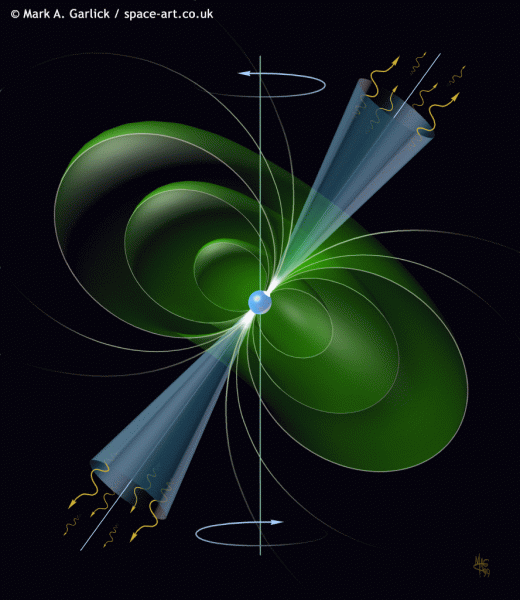

Isolated Pulsars are neutron stars with strong magnetic fields which emit on a narrow beam along their magnetic axis. The magnetic axis is inclined respect to the rotational axis and the pulsar acts like a lighthouse becoming visible when the beam intersect the line of view. The emission, that is produced at expenses of the rotational energy, is modulated with the star rotation period. The first pulsar was discovered by Hewish et al, (1968) in the radio wavelengths and, since then, the number of known radio pulsar has increased considerably. The origin of X-ray emission from this sources is attributed either to thermal and non-thermal process. Thermal emission is characterized by two components at different temperatures. The first component, with a temperature lower than 100 eV, originates from the cooling of stellar surface. The second one is produced in the polar cap regions, two regions around the magnetic axis, heated by accelerated particles that move towards the stellar surface. Its characteristic temperature is about 100-500 eV. The pulsar non thermal emission originates from charge particles accelerated in magnetospheric regions where strong electric fields are present. The location of these regions, called gaps, is not clear. Two classes of models exist at the moment: polar-cap models, with their evolution in the slot gap model, where the acceleration and radiation occur near the stellar surface, and outer-gap models where these processes occur in the outer magnetosphere.
Pulsars at IASFPa
Study of isolated pulsars at IASF-Palermo has historical tradition. It started with the ESA mission COS-B that observed the sky above 30 MeV from 1975 to 1982 and was the main research field for the Institute. The first logo of this Institute was the Vela pulsar light curve observed with COSB.
Another historical experiment, was the balloon borne French Italian gamma ray observatory FIGARO opportunely designed to study sources with a well defined temporal characteristic. It was working in the range 0.15-4 MeV and produced interesting results as the detection of a line at 440 keV in the Crab pulsed spectrum interpreted as annihilation line red shifted for gravitational effects (Massaro et al. 1991) and confirmed by Ling et al. 2003 using data from BATSE. The activity continued with BeppoSAX whose wide energy band allowed the model the Crab pulsed emission with the multicomponent model, and to define a curved model well suitable to describe high energy emission from young Crab-like pulsars.
Researcher at IASFPa are at the moment involved in the study of Gamma-ray emission from pulsars with AGILE and Fermi-GLAST satellites.
The Crab pulsar: the multicomponent model
The Crab pulsar is the prototype of magnetospheric emission. It is the pulsar located at the center of the Crab nebula remnant produced in the 1054 AD by a supernova explosion. Its pulsed emission is characterized by a double peaked light curve whit the peculiarity that the two peaks keep the same phase position from radio to Gamma-rays up to the GeV range.
Researcher at IASFPa developed an heuristic model able to describe the Crab pulsar emission at high energies from the optical to Gamma-ray energy range. The model is based on the assumption that the light curve can be described as combination of two components with different phase shapes. The first, plotted in red, in the Figure is the light curve observed in the optical range and is named Co, the second marked in blue has an ad-hoc shape that allows to describe the observed light curves and it is named Cx. Moreover, each phase component is characterized by its own spectral shape composed by two curved power law models, the first with a SED peak in the X-rays and the second in the Gamma-rays. The combination of these two spectra well describe Crab spectral variations with phase from optical to EGRET ranges. The model well foreseen also the light curve shape recently detected above 25 GeV by MAGIC (Aliu et al 2008). The figure below shows the light curve detected by MAGIC with superimposed (red line) the light curve derived from the multicomponent model extrapolated at 25 GeV. It is not a fit but well agree with the observed shape.
The multicomponent model, even if heuristic, can give indications to pulsar models. A first indication is that multiple emission regions could exist in the pulsar magnetosher, while the canonical models consider single acceleration regions. Moreover, the model suggest as emission mechanism synchrotron from secondary particles in the X-ray range and inverse Compton scattered radiation in the Gamma-rays.
The X-ray curved model
This spectral model, used to describe the spectral variation of the Crab pulsar from optical to X-rays, has been applied to several other Crab-like pulsars.
It is characterized by a continuous steepening power law whose spectral index changes linearly with the logarithm of the photon energy. The variation of the spectral index over one decade of energy is measured by the bending parameter b. This model is well suitable for modeling spectra with a mild curvature and with symmetric behavior respect to a peak energy Ep.
The Table shows the values of bending parameters and peak energy detected in the Crab-like pulsars where it was possible to apply this model.
| Source Name | b | Ep | References |
| Crab Pulsar(P1) | 0.14+/-0.02 | 14 keV | Massaro et al. 2006 |
| Crab Pulsar(Ip) | 0.16+/-0.01 | 178 keV | Massaro et al. 2006 |
| PSR B1509-58 | 0.13+/-0.02 | 5.4 MeV | Cusumano et al. 2001 |
| PSR B0540-69 | 0.25+/-0.06 | 12 keV | Campana et al 2008 |
| PSR J0537-6910 | 0.16+/-0.07 | 70 keV | Mineo et al. 2004 |
This emission could be produced by electron moving within a magnetic field with an acceleration inversely proportional to the energy. This condition can be achieve, for example, if particles are confined by a magnetic field with an efficiency that decreases for an increasing gyration radius.